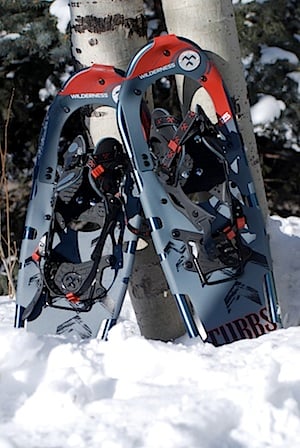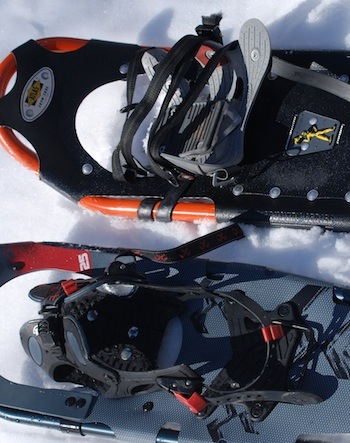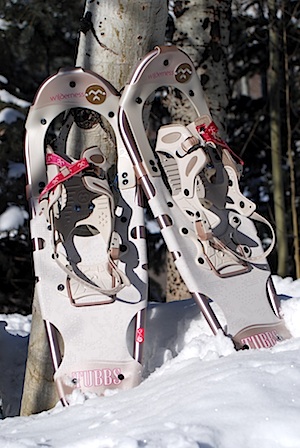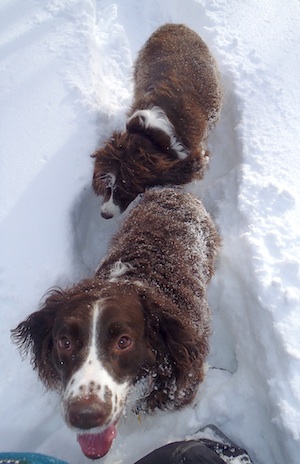Winter's snows reveal who went before you when you're exploring a national park. Snowshoe hare tracks are as distinctive as those of a magpie or fox.
Venture into snow-bound Yellowstone, Grand Teton, or Glacier national parks and you might happen upon the tracks of a wolf or, as I was fortunate enough to spot, the feathery outline of a raven that came down to snatch a morsel from the fluffy snow's surface.
Many national parks turn into wilderness wonderlands through the months of December, January and February, and often remain so through March. They are snow-covered expanses that invite discovery. But when snow depths move past 5 or 6 inches, a good pair of snowshoes can be invaluable for negotiating both the increasing depths without 'post-holing' up to your knees or more, as well as providing traction on slopes and across any ice you might encounter.
Shenandoah, Acadia, and Great Smoky Mountains national parks in the East are the most obvious choices for snowshoe adventures, though places such as Prince William Forest and Delaware Water Gap National Recreation Area also are great candidates. Continue to move west and Pictured Rocks, Indiana Dunes and Sleeping Bear lakeshores can be destinations after hefty storms, as can Tallgrass Prairie National Preserve, as well as Voyageurs, Theodore Roosevelt, Rocky Mountain, Grand Teton, Yellowstone, Glacier, Sequoia, Yosemite, and Mount Rainier national parks, just to name some of the most obvious snowbound candidates.

The men's Wilderness 25 from Tubbs. Kurt Repanshek photo.
But What Do You Put On Your Feet?
While wood-framed snowshoes would be the romanticist's choice, they long have lost market share to shoes made with aluminum frames, frames that support synthetic decking materials as opposed to rawhide lacing.
Too, men and women are somewhat different anatomically, particularly around the hips, and the snowshoe manufacturers take that into consideration these days. They also recognize you might have kids, and offer lines of shoes that not only will fit your children well, but also come with colorful treatments that attract youngsters' attention.
“Women – with wider hip and, a different center of gravity than men, and a tendency to be knock-kneed rather than bowlegged – often are more comfortable on snowshoes build on asymmetrical frames. The outside of each tail is straighter than the curved inside, eliminating even the feeling of stepping one’s own snowshoes," says Claire Walter, author of Snowshoeing Colorado and The Snowshoe Experience.
The improvements have been incredible in many respects when you gaze at the old trapper's Bearclaw shoes. And that has to frustrate snowshoe manufacturers, since the lifespan of a quality pair of shoes today is not short.
I have a pair of shoes purchased more than a decade ago from the Atlas Snow-Shoe Co. that, while scratched from toe to heel and mended with Home Depot hardware, still perform admirably. But that doesn't mean it might not be time to upgrade to one of the latest models. The improvements in aluminum frames, decking, and bindings all are reasons to see what's on the market.
Tubbs' Wilderness Model
This winter I've had the chance to field test a pair of Tubbs Wilderness 25 (MSRP $199.99) shoeshoes, one of the company's more popular models, and so far have been impressed with their performance. Though shorter than my Atlas shoes, the loss of 5 inches in terms of flotation hasn't been noticeable, and most likely won't be for most users, unless you frequently tackle fresh snowfalls of 18 inches or more.
The Wilderness profile also is a bit narrower, by three-quarters-of-an-inch under the toe, which allows your stride to be a bit more natural, without the need to walk "wider" to keep the shoes from colliding as you hike. For women, the shoe is even a bit narrower for ease of walking, but you don't suffer in lost performance.
Bindings have improved greatly since I bought my Atlas shoes. Woven straps that run across the top of your foot and around your heel in places have been replaced with rubber ones, and the sidewalls of the rubber binding have grown in size to become more embracing of your foot.

This closeup of the older Atlas shoe on top and the Wilderness 25 on bottom shows the improvements in binding construction. Kurt Repanshek photo.
The result is simply better fit and improved mobility. Tubbs, which has been making snowshoes since 1906, also outfits the Wilderness with a circular carbon steel toe crampon under the ball of your foot, as well as two toothed crampon bars running beneath the heel of your boot for added traction on slopes and ice.
Finally, the Wilderness 25 also offers what Tubbs calls its ActiveLift heel lift. This is a metal bar that you can raise up under your boots' heels when you're climbing steep trails.
The bar helps ease the strain on your Achilles tendon and calf muscles. It really does do the job, though it puts you in an awkward posture when the slope levels out. As a result, if you're heading up a trail that rises and falls, you could find yourself raising and lowering that bar a lot...or simply leaving it down.
There are quite a few players in the snowshoe industry these days, a half-dozen or so major manufacturers. Short of spending a month testing the various models, let's look at some of the differences with Atlas and Tubbs, since I'm most familiar with their products and it makes it somewhat easy to look at improvements that have been made over the years.

Tubbs makes a woman-specific version of the Wilderness. Kurt Repanshek photo.
One difference between Atlas and Tubbs is Atlas uses a "spring-loaded" suspension in some of its models. While the company touts this as improving lateral flex of the shoe, something useful on side slopes, and putting a little spring in your step, a downside is the tail of the shoe tosses snow up against your thighs and back as you walk. And if the snow is on the moist side, you won't be happy. Of course, one solution to that can be waterproof shell pants, which you'll likely be wearing any way when you head out into the snow.
Tubbs, on the other hand, promotes its "Rotating Toe Cord" design under foot that is designed to let the tail of the shoe drop as you stride and thus shed snow.
To demonstrate how high-tech these designs have become, Tubbs touts that its Rotating Toe Cord reduces "cardio-respiratory strain by 7 percent" versus shoes without it.
A innovative approach Atlas has taken to its bindings is that on some models you can both loosen and tighten the bindings with one pull on a strap for easy fast entry and exit.
There are a number of snowshoe manufacturers out there -- Tubbs, Atlas, Redfeather, Crescent, Northern Lights, and MSR (Mountain Sports Research) are some of the more well-known ones. While differences from shoe to shoe might seem minor, nothing beats being able to put on a pair and try them out to examine the different features and decide for yourself what makes a difference and what is simply a marketing ploy.
Check with your local snowshoe dealer to see what events are on tap. Another step in the decision-making process would be to visit the respective manufacturer's websites, as some offer videos that go into the details of their designs.
Things to consider when looking for snowshoes:
* What type of snow do you receive? That's not as odd a question as you might imagine. Rocky Mountain snows tend to be on the light and dry side, which means you'll need more flotation (a longer shoe) as the snow won't compact as quickly as wetter, more dense snows.
* Where do you intend to snowshoe? If you mostly follow the beaten path, you won't need as much flotation as if you were adventuring off-trail through the woods and over mountains.
* Your weight. The more you weigh, the longer shoe you need to provide the requisite flotation. And don't forget to factor in any pack you might be carrying.
* What type of snowshoeing do you plan to do most of the winter? A wide variety of models exist, from slimmed-down $300+ "racing" shoes that weigh barely 2 pounds a pair, to nearly 3-foot-long shoes approaching the $300 limit that are designed to take you to the mountain top. And, of course, there are kid-sized snowshoes so you don't have to leave the family inside while you go exploring.

Now, you can't take your dogs snowshoeing in the parks, but if you head out with them into a national forest, they'll love you for breaking trail. Kurt Repanshek photo.
Things to keep in mind:
* A stout, well-insulated boot is invaluable when you're out for hours in the snow. Cold feet are not happy feet. Depending on the height of the boot, you might also want a gaiter to keep snow out, unless your shell pant has a gaiter incorporated into it.
* Whether you need poles is a matter of personal preference. They can offer added stability, particularly when you're coming down steep slopes.
* Snowshoes will not prevent you from sinking into the snow. You will not magically float across the surface. They will, however, minimize, relatively, how deep you go. (See the above note about snow density).
* Many manufacturers make gender-specific snowshoes, so if you're looking to surprise your spouse, make sure you surprise them with the right model.
* Dress in layers, and if you plan to be out for a couple hours, a daypack is a great thing to have, not only to put layers into as you grow hot, but also to haul some water and snacks.


 Support Essential Coverage of Essential Places
Support Essential Coverage of Essential Places







Comments
Tubbs is a great company, replaced a broken binding on my ages old shoes, with the newer better bindings in no time no worries.
Have been on a pair of MSR (Mountain Safety Research) Lightning Ascents the last decade,
..or so :-]
Glad to see you're still lurking, RW;-)
I was actually wondering today if I could get updated bindings on my old Atlas shoes. One can never have enough snowshoes in your quiver!
I have several pairs including Tubbs, but I highly recommend Redfeather. Part of a family of brands under a non-profit corporation whose primary goal is to hire people with disabilities. Great product, great service, great cause.
Oh for sure Kurt, I might wander away for some time only to find myself, upon return checking in here with you all. I'd bet Atlas (800-985-8012) would take care of those shoes. One of their (non warranty) repair centers is in Oregon, the other somewhere past the Rockies. Haver a pair of loaners myself...
Let me ask a stupid question. Why do people own more than one pair of snowshoes?
Steve
They have friends that come visit.
Steve, ec is partially right.
But different snow conditions can merit different snowshoes. For instance, deep fresh powder would call for your longest shoe for better flotation. If the snow is damp and heavy, or packed down where you're doing, you'd use a shorter shoe. And if I was 20 years younger, I'd consider a sport snowshoe for snowshoe races. And, with evolving technology, snowshoes get lighter.
Bottom line is that it all depends on both the conditions and your particular activity in the snow.
Thanks guys. I guess since nobody visits me, ecbuck's answered never occurred!!!!